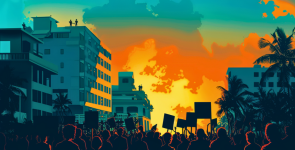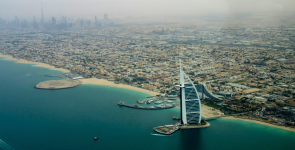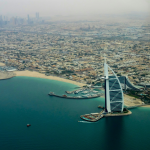By Guest Writer: Mohamed Ryan Thoyyib
Maldives has always been a well-known travel destination for honeymooners and divers. People travel from all around the world to enjoy the pristine waters and white sandy beaches. However, in recent years the waters of Maldives have started to fill with more and more surfers staying on charter boats, guesthouses and resorts.
Surfing in Maldives began when an Australian named Anthony Hussein Hinde (Tony) was shipwrecked on a reef in 1973. Tony discovered the surfing potential in Maldives and kept the surf spots a secret for almost 15 years, surfing them with only a small group of friends. He then started a surf operation known as Atoll Adventures in 1980 at Pasta point. Tony passed away in 2008 after surfing his last wave at Pasta point. He left behind a growing legacy that continues to provide surfers opportunities to enjoy endless waves in a sustainable way while also creating a significant source of income for a beautiful nation.

Sultans and Honkeys. Photo: Dara Ahmed
With many high quality, consistent and easily accessible surf breaks, Maldives has become one of the top surf destinations in the world. International surf competitions have been held where top athletes have showcased their exceptional wave riding skills. Some of the most well known surfers like John John Florence, Jordy Smith, Bethany Hamilton and Lakey Peterson have visited the Maldives purely for the experience of the amazing waves found throughout the country. Some people wonder why surfers pay a fortune and travel to the Maldives from surf rich countries like Australia, USA, Brazil and South Africa. This is mainly due to the crowd factor. Even though Maldives is starting to become more popular amongst the surfers, it is still blessed with uncrowded waves. North Male’ atoll comprises of the most popular and consistent breaks like Sultans, Honkeys, Jails, Cokes and Chickens, growing in demand every year. The further north or south you travel away from the capital, Male’, you will find many more breaks where you can enjoy the waves all to yourself. Surf breaks on high-end resorts like Pasta point, Lhohis, Kandooma Right and Vodi limit the number of surfers, affording you some luxury to enjoy the waves without big crowds and hassle.
The Southern Atolls are common for guests staying on Charter boats where you have the opportunity to move from one surf break to another depending on the wind, current and tide on that particular day. Some of the surf breaks at the most Southern Atolls like Blue bowls, Love charms, Five islands and Tiger stripes are known to be quite “heavy” and aren’t for the faint hearted. If you are a budget traveler many local islands have guest houses which offer more basic accommodation but offer you easy access to some of the best waves you have ever seen.

Tiger stripes. Photo: Ibrahim Ayaz
Maldives consists of mainly reef or point breaks. Due to the lack of beach breaks the surf breaks are not suitable for beginners and are more for intermediate to advanced surfers. Powerful waves are formed here from ground swell, which are a group of long-period waves created by a distant storm system. These high-energy waves travel thousands of kilometres and start to peel once it hits a reef. As they move up a gradual incline of a reef, they begin to slow down. The bottom of a wave slows more quickly than the top. And thus a wave breaks when the crest goes far over the trough. Different types of reefs create long, short, mellow or dumping (hollow) waves that can be surfed. The unique reef formations found in Maldives create these perfectly peeling mechanical waves over and over combined with favorable tide, current and wind conditions. These natural factors help create good quality waves to make Maldives the perfect surf haven for hardcore surfers.
Surfing has increased in popularity as a sport and lifestyle for Maldivians, and the number of surf tourists visiting the country grows each year. This is now leading to challenges such as overcrowding at some surf breaks. With the number of surf breaks in the most populated areas being limited, surfing could become unsustainable. In other areas of the world these challenges have been addressed by introducing artificial waves and surf reefs. Man made waves have become common in the last few decades. First came standing waves where you can surf on a wave artificially created in one spot without traveling at a longitudinal distance. Artificial standing waves don’t take up too much space and have been built inside shopping malls in Germany and also on cruise ships.

Artificial standing wave. Photo: flowrider.com
With the improvement in wave building technology came wave pools. Artificial standing waves will never match the technology and experience a surfer gets from artificial wave pools, as these waves formed in wave pools closely mimic the shape, power and feeling of an actual wave. In recent years there have been many methods of artificially generating waves for surfing in wave pools. Compressed air, levers and paddles, and pulling a submerged block along a track, all produce surf. Kelly Slater’s Surf Ranch in California is currently the most well-known artificial wave pool in the world. A 100-ton hydrofoil vehicle runs down a track in the middle of a rectangular pool producing a swell that hits specific areas and contours on the pool’s bottom to make the wave break. This was the first ever wave pool to show a perfect peeling wave with different sections used for a surfer to complete high performance maneuvers and also get “barreled”. Unlike many natural waves, Kelly’s wave pool generates waves that can be ridden for 45 seconds. Another great wave pool at the BSR Surf Resort by PerfectSwell offers a different kind of perfection to that of kelly’s wave pool. A perfection that more closely resembles the setup of a natural surf break. Waves are generated through a series of air pistons mounted within a central wall. Even though the waves here last about 8-10 seconds it generates 160 waves per hour, which is a lot more compared to the 15 waves per hour at Kelly Slater’s Surf Ranch. Kelly’s wave could be the most perfect artificial wave out there but PerfectSwell’s wave is definitely much more playful and closer to an actual surf break. There are only a few proper artificial wave pools in existence, although with new knowledge and technology, there are many more in the pipeline.

Left: Kelly Slater’s Surf Ranch. Photo: outsideonline.com / Right: BSR Surf Resort by PerfectSwell. Photo: raisedwaterresearch.com
Other than the two types of artificial waves mentioned above, an Artificial Surf Reef (ASR) is a man-made underwater structure placed in an actual lagoon or reef with the purpose of improving surf conditions. The demand for ASRs are increasing as surfing grows more popular. With surf breaks getting more crowded each day researchers have been trying to develop new breaks and also improve existing breaks with better quality surf. Waves break in different ways, and largely depend on the profile of the seabed underneath them known as bathymetry. In Maldives and other island nations made up of reefs, the characteristics of a breaking wave mostly depends on the shape and slope of the reef. A lot of current ASRs are made up of large rocks or geotextile bags buried at a key point offshore to give the waves a boost in breaking and peeling early in places where they might otherwise close out. For a surfer if a wave closes out it is unfavorable as you don’t have enough time to ride the wave. This is where an ASR comes into play.
The optimal dimensions to the design of an ASR remain an uncertainty, however it can be estimated with the help of a combination of numerical and experimental modeling. Carrying out bathymetrical surveys of idealized surf breaks can also help identify important reef properties. A study carried out by Henriquez, 2005, ‘Artificial Surf Reefs’ suggests that the quality of a surf break is expressed in four measurable parameters: breaker height, breaker shape, peel angle and the attendant currents. He identifies in the image below that identifying whether a wave is surfable or not depends mainly on the value of the peel angle α. Other than that there are still many more factors that need to be taken into place when building an ASR, like the currents and tides to name a few.

Illustration of wave celerity vector c ⃗, peel rate vector (Vp) ⃗, down-line velocity vector (Vs ) ⃗and peel angle α. Photo: surfermag.com
The Eastern side of the island Hulhumale’ consists of waves that break onto the outside of the reef. Surfers have been seen surfing on a few spots around this area. The surf here is not as consistent as other surf spots and breaks quickly onto dry reef. Local surfers here have mentioned that the rides you get are very short and that the waves closeout quickly. However, they get longer rides with a bigger swell coming from the South, Southeast direction. The image below shows an area in Hulhumale’ that has the potential to create better quality waves with the installation of an ASR.

Potential surf break on Eastern side of Hulhumale’ which can be improved by installing an ASR.
Even though there is a lot of data on how waves are formed, there is no or very limited research specific to the Maldives. A lot more studies have to be done to identify how good quality waves are naturally generated in other parts of the country. Maldives has very unique features as an island nation. Tides and winds are quite easy to predict. But the direction and time period that currents occur in the ocean, and especially surf breaks within the country, are still hard to predict. Bathymetrical surveys and 3D mapping needs to be carried out at different surf spots in Maldives in order to identify and display reef structures, which will definitely help in deciding the characteristics needed for a functioning ASR in this location. As mentioned above, rocks and geotextile bags can be used to make the ASR. But a few projects such as the one in Bournemouth, UK, have failed where these structures were not strong enough and were dismantled with bigger swells making it dangerous for public use. Recently an inflatable surf reef called the Airwave was introduced in Western Australia where a sail-like sheet of canvas is anchored to the ocean floor, with an air bubble underneath. The two metre high dome shaped bladder is designed to mimic the shallow leading edge of a reef to create a surfable wave. The airwaves are constructed from a long life, super strong, environmentally safe compound, designed to have minimal adverse effects on the environment. The only downfall is that it is currently not designed for swells greater than two metres. Hence, with new ideas like this, ASRs are becoming more efficient in creating or improving surf breaks and could be a breakthrough to overcome the unfavorable crowding of surf breaks.

Cross-section of the Airwave. Photo: magicseaweed.com
Artificial waves, wave pools and ASRs are innovative and exciting. But are they needed for the Maldives? Maldives is a surf rich country consisting of easily accessible remarkable waves. Artificial waves and reefs cost millions of dollars to be built but can be beneficial for a country or certain area that lacks good surf. Artificial waves and wave pools are probably not needed in the Maldives at the moment. However an ASR could help improve the wave quality of existing areas with poor surf conditions in Maldives, and also possibly create surf breaks in lagoons that contain no reef but consistently gets swell. An ASR can also benefit as a breakwater by protecting islands from erosion. With all of this said, surfing natural waves are free and the unpredictability of the surf conditions make it more adventurous for a surfer. Maldives has many high quality waves and there are many more breaks to be discovered. Recently there have been cases where top class waves have been destroyed in the name of economic development. With the installment of the Male’ – Hulhumale’ bridge, the surf break in Male’, ‘Raalhugandu’ was temporarily closed for months, cutting off access to the only break for surfers based in Male’. Since completion of the project, the wave itself has been negatively affected. A break on the Northwest side of Male’ known as ‘Rats’ has been completely wiped out. The surf break on Villimale’ is also currently facing a threat with the construction of another bridge. Moreover, the construction of a resort on Kuda Villingili introduced a seawall that is causing backwash and affecting the currents at ‘Chickens’. Tourists come to enjoy the pristine natural playgrounds that Maldives has been blessed with. Policy makers and investors should realize that there is more ecological and economic value in protecting these reef breaks. Rather than creating waves, it would be more sustainable and beneficial for the Maldives’s surf industry to protect and preserve these natural playgrounds.

About the writer: Mohamed Ryan Thoyyib is a graduate from Plymouth University, UK with BSC (Hons) in Surf Science and Technology. He is currently working as a surf guide at Atoll Adventures.



















